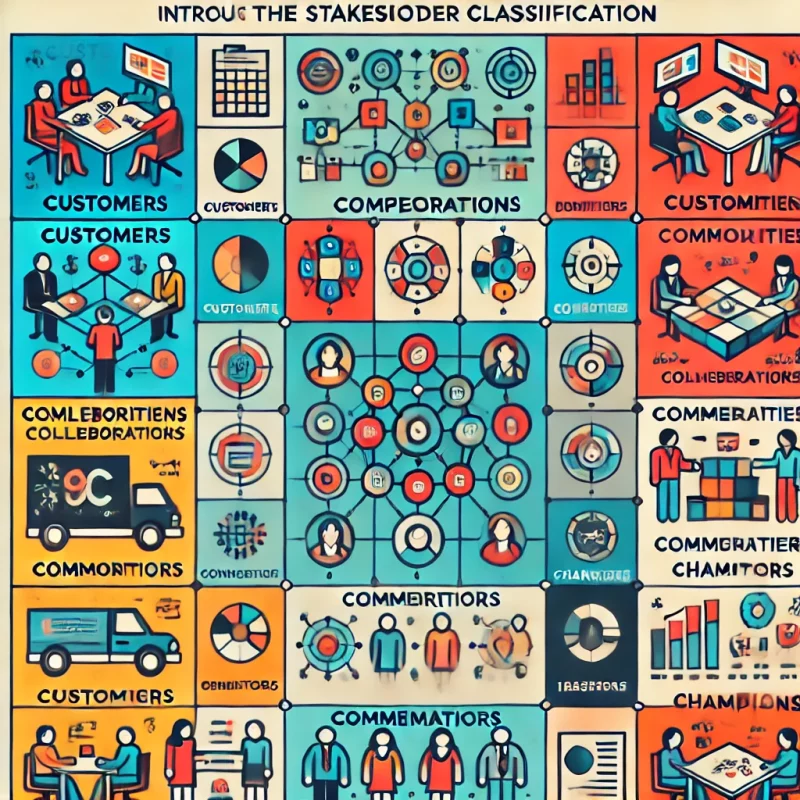The 9C Model: How to classify your stakeholders
Once you have mapped your most important stakeholders, before calculating your potential stakeholder influence score and set up an outreach strategy to engage with them, you should classify them.
There are different types of classifications, a famous one is the Mandelow matrix, which we have explained in a previous post.
Today, we would like to introduce you to the 9C stakeholder classification method. A simple framework which will help your business to make clarity among the actors that have an interest on them.
What is the 9C model for stakeholder classification
The 9C Model in stakeholder analysis is a comprehensive framework designed to help businesses and organizations identify, categorize, and understand their stakeholders.
By applying this model, you can ensure they are addressing the needs, concerns, and influences of various groups that impact or are impacted by your activities.
Unlike traditional models that may focus on a limited set of stakeholders, the 9C Model offers a more detailed approach, encouraging a holistic view of all parties involved. This technique is particularly valuable in strategic decision-making, as it highlights the diverse range of interests that need to be considered for successful outcomes.
Your stakeholders in 9 categories: The 9C Model in action
The 9C model breaks down stakeholders into nine key groups, each represented by a “C.” Here is the complete list
| Category | Description |
|---|---|
| Customers | Those who purchase or benefit from the product or service. |
| Competitors | Other businesses or entities that offer similar products or services. |
| Collaborators | Partners, suppliers, or entities that work together with the business. |
| Communities | Local or global groups affected by the business activities. |
| Contributors | Individuals or organizations that provide resources or input (e.g., employees, investors). |
| Channels | Distribution or communication networks that help deliver products or services. |
| Commentators | Media, influencers, or others who provide commentary or opinion about the business. |
| Consumers | End-users of the product or service (can be different from customers). |
| Champions | Advocates or promoters who actively support the business or its causes. |
What to do once you have classified your stakeholders
Once stakeholders are classified into the nine categories of the 9C Model, the next step involves strategically managing these stakeholders based on their roles, needs, and potential impact on the business or project. Here are the key actions to take after classification:

Assess Interests and Influence
Understand Needs: Determine the specific interests, needs, and concerns of each stakeholder group. For example, customers are interested in product quality, while collaborators might focus on mutual benefits.
Evaluate Influence: Identify how much influence each stakeholder group has on your business outcomes. While the 9C Model doesn’t explicitly rank influence, you can assess which groups hold more power or urgency in the context of your goals.
Prioritise Stakeholders: Prioritize groups that have the most direct impact on your business, such as customers, consumers, and collaborators. These groups may require more frequent communication and attention.

Develop Engagement Strategies
Tailor Communication: Customize your approach for each category. For instance, consumers might need marketing campaigns, while champions could benefit from advocacy partnerships. Use our engagement tools.
Collaboration Opportunities & Manage Relationships: Explore partnership opportunities with collaborators or influencers who can enhance your business.

Monitor, Adapt and Mitigate Risks
Measure Engagement: Track how effective your engagement strategies are by monitoring interactions, stakeholder satisfaction, and the impact on business performance. You can do this by applying the stakeholder influence score.
Identify Potential Conflicts: Recognize stakeholders who might have conflicting interests, such as competitors or commentators, and develop plans to manage or mitigate any risks they pose.
Crisis Management: Have contingency plans for stakeholder groups (e.g., media or communities) that could negatively affect your reputation or operations if not properly engaged.
Advantages and disadvantages of the 9C Model
The 9C Model for stakeholder classification offers a structured approach to identifying and managing stakeholders, but like any framework, it comes with its own set of advantages and disadvantages.
Remember to first identify the aim of your classification and the time you want to spend in doing it. Not every business needs to deal with the study of their stakeholder so deeply!
Advantages
- Comprehensive Scope: The 9C Model ensures a broad view of stakeholders by considering all potential influences and relationships
- Holistic Approach: It encourages to think beyond traditional stakeholders like customers and investors
- Adaptability: The 9C Model is flexible and can be applied in a variety of industries, from business and government to non-profits, making it a versatile tool for different contexts.
Disadvantages
- Complexity: The model’s broad scope can make stakeholder analysis more complex and time-consuming
- Resource Intensive: Given the extensive stakeholder identification process, the 9C Model might require more resources in terms of time, effort, and personnel, especially for smaller organizations with limited capacity
- Prioritization Challenges: With so many groups to consider, businesses may struggle to prioritize stakeholder interests, potentially leading to inefficient decision-making or neglect of more critical stakeholders.
- Lack of Focus on Influence or Power: Unlike models like the Mendelow Matrix, the 9C Model doesn’t prioritize stakeholders based on their influence or power, which may result in an inefficient allocation of resources for engagement.
You don’t know where to start?
Let us help you!


No responses yet